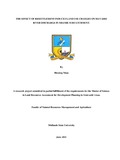Please use this identifier to cite or link to this item:
https://cris.library.msu.ac.zw//handle/11408/3250| Title: | The effect of resettlement induced land use changes on Mavaire river discharge in Shashe subcatchment | Authors: | Ndau, Blessing | Keywords: | Land use Resettlement |
Issue Date: | 2015 | Publisher: | Midlands State University | Abstract: | Land use changes have been occurring as a result of human uses for developmental purposes. These changes will certainly have a negative influence on the hydrological characteristics of catchments, thereby inducing an increase in surface runoff, soil erosion and sediment inputs. In the year 2000, Rio Tinto discovered kimberlite diamonds in Murowa, Zvishavane. This discovery led to the relocation of 142 families to Shashe resettlement block in Masvingo Province near Mashava. The area which was once rangeland area was then converted to settlement and cultivation in 2004. The land conversion has had significant effects on runoff which results in sedimentation of the Mavaire river. To determine the effect of the resettlement induced land use changes on Mavaire river discharge firstly, the spatial and temporal land use changes that took place in Shashe were determined using landsat images with ArcGIS 10.1 and the results showed that a significant change in the spatial and temporal land uses existed. The major land use changes which took place for the 3 years of 1998, 2006 and 2014 were as follows; Water percent area was decreasing for this time period and it was 1%, 3% and 2% respectively. Mining percent area was also decreasing and was 18%, 12% and 4% respectively. A decrease in forest area was also noted. It was 29%, 22% and 3% respectively. Grassland percent area was 34%, 16% and 12%. Cultivation percent area was 13%, 17% and 32%. Rangeland was 29%, 30% and 47%. Secondly the relationship between the selected land uses and runoff was then tested using linear regression. Further statistical analysis was done with R2 value and standard error. A strong relationship between selected land uses and runoff of Mavaire river was found. A strong positive relationship was y = -0.146x+66713 for mining, the R2 value 0.970 and it had a standard error of 18% .A decrease in forest area resulted in an increase in runoff and a strong positive relationship existed between the two at a slope of y = 0.077x+66669. The R2 value was 52% and its standard error was 0.930. Cultivation area was increasing, this resulted in an increase in runoff at a slope of y = 0.125x+65790. The standard error was 32% and the R2 value of 0.930. Rangeland area was also increasing but it resulted in a decrease in runoff at a slope of y = 0.119x+65433. The R2 value was 0.786 and its standard error was 54%. The results from this research are particularly relevant for Shashe resettlement block in formulating, implementing and monitoring strategies for sustainable development such as farmer training programmes on conservation agriculture, promoting the use of biofuels to reduce deforestration, also monitoring of the cutting down of trees with the help of the Environmental Management Agency and chiefs as well as headmen with the help of the Ministry of Agriculture should designate properly managed paddocks to control overgrazing. The government and eminent domains should also ensure that negative effects of resettlements are given due consideration in the planning procedure to avoid environmental consequences. Also there is need to conduct research on future land use change effects on dam sedimentation of Mavaire river. | URI: | http://hdl.handle.net/11408/3250 |
| Appears in Collections: | Msc Land Resources Assessment For Development Planning Degree |
Files in This Item:
| File | Description | Size | Format | |
|---|---|---|---|---|
| BEE NDAU PROJECT.pdf | Full Text | 1.38 MB | Adobe PDF |  View/Open |
Page view(s)
316
checked on Jan 18, 2026
Download(s)
138
checked on Jan 18, 2026
Google ScholarTM
Check
Items in MSUIR are protected by copyright, with all rights reserved, unless otherwise indicated.



